WinHEC 2005: Coverage Wrap
by Derek Wilson & Jarred Walton on April 29, 2005 2:00 PM EST- Posted in
- Trade Shows
Prototype Media Devices
We've snapped pictures of some of the units that were being demonstrated at the show that were targeting the media center audience. There are of course numerous ways in which to approach such a market, but we'll be focusing here on the more unique designs. Probably half to two-thirds of the booths in the Expo Hall had a media device present, with one to many streams of HD and/or DVD content all running in real time.Texas Instruments
 |
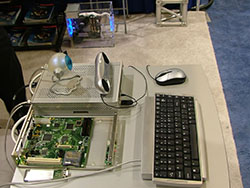 |
| Click to enlarge | |
Texas Instruments was demonstrating this "Split Chassis PC Product". While the main system was a standard PC connected to an HDTV, the small module you see above was connected to the main system via an X1 PCIe cable. With a bidirectional data rate of 2.5 Gbps (250 MBps data throughput, as 62.5 MBps is used for communication overhead), the connection is more than capable of handling all of the necessary traffic. The end result is that the large media processing PC can be stored out of sight and the only visible interface is this small box, roughly the size of a typical 5.25" DVD drive (2x7x10 inches). Keyboard, mouse, USB, Firewire, and audio connections are all present on the "I/O Hub", along with IDE and CardBus/PCMCIA and a flash card reader.
Texas Instruments feels this provides a compelling solution, with the PCIe X1 cable providing up to 7 meters of distance between the main PC and the I/O Hub. The PC still needs to be close enough to connect to your HDTV, of course, which is a limitation of the DVI or component video cables that are used. There are certainly some interesting use cases for the design, i.e. a console located in a unit next to your sofa with the noisy PC placed where it can be neither seen nor heard. Couch potatoes of the world will rejoice at the ability to change a DVD without ever standing up!
Embedded Device Processors
While the Athlon and Pentium processors receive the lion's share of attention these days, there are still many alternative processors that can be used for media devices. Intel has the XScale architecture, which is non-x86 - it's an extension of the ARM5TE architecture. There may have been some devices using this processor, but we didn't notice any. Moving on, AMD has their Geode GX and NX processors, VIA has the Eden CPU as well as a new Luke processor, and Transmeta has their Efficeon processors. We've got images of some prototypes for all of these platforms.AMD Geode
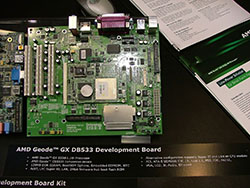 |
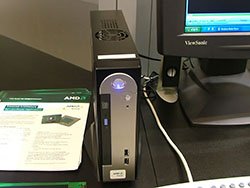 |
| Click to enlarge | |
Starting with AMD, the Geode processor is designed as a low power embedded solution. The GX model shown above-left consumes a miniscule 1.1W at 533 MHz. For video content, a hardware decode/encode chip would be required for most formats. The NX is a higher performance version, as well as a higher power device. We didn't get a clear shot of the screen, but DVD quality video was being decoded without problems from the system on the right. Without some additional hardware assistance, HD content would probably have difficulty, however.
Transmeta Efficeon
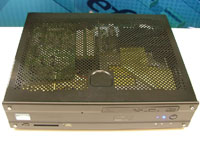 |
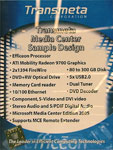 |
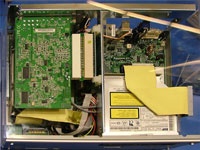 |
| Click to enlarge | ||
Our next stop was at the Transmeta booth, where they were demonstrating their 100% silent media center sample. You can see the internal components as well as their exterior. According to the booth personnel, the sample unit was designed and built for the show in only a few months using mostly off-the-shelf hardware. A couple of the more interesting aspects are the use of a dual-tuner card (that's the large add-in card you see on the left of the image), allowing for recording one channel while a second is being watched. We're not convinced about the need to handle 4+ simultaneous streams, but there is definitely a good use case for handling at least two streams.
It's also interesting to note that a Mobility Radeon 9700 was used in their prototype, which is probably a lot more power than most companies would put into a media center device. On the other hand, that does give them the ability to handle Longhorn (with the Aero Glass UI) once it ships. With no fans on the system, it should be totally silent (other than perhaps the DVD drive when it's in use) - not that we could verify this over the crowd noise. However, we're a bit concerned about long-term reliability, and a single temperature sensitive, low-RPM fan might be a useful addition. This would help to guarantee that the HDD and other components are kept cool, helping to increase their lifespan. This can be particularly important during the summer months.
VIA Eden and Luke
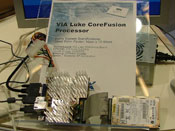 |
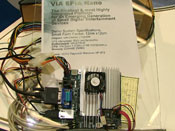 |
 |
| Click to enlarge | ||
Our last examples for media center devices come from VIA. The Eden processor has been around for quite some time, but this was the first we had heard of the Luke processor. Basically, it was their North Bridge solution with the Eden integrated - and we say it that way rather than the Eden with an integrated NB as the NB is roughly 3X the size of the CPU! The whole board is covered by a passive heat sink, but you'll note the small size of the board: 10cm x 10.5cm; it's not much larger than the attached 1.8" HDD. While the Luke setup was only shown powering XP, a nearby Nano platform was shown decoding 720p HDTV without trouble. (The photo is blurry due to our camera and photography skills, not the LCD or platform.) Via touts the Nano platform as being the "most highly integrated platform for small digital entertainment devices," and at 12cm x 12cm it certainly isn't large. Now they just need to clean up their wiring....
VIA SMP Eden
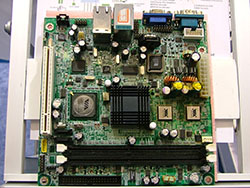 |
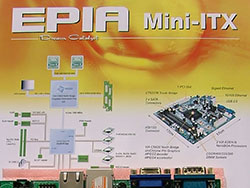 |
| Click to enlarge | |
We didn't get a shot of the working prototype system (well, we did but it was so blurry that it was unusable), but we did get some photos of the board and specs for VIA's take on the SMP market. That's not how they described it, but we thought the dual-processor Eden setup was rather intriguing. At 17cm x 17cm, it's larger than their other demo platforms, but it also includes quite a few more features. Besides the two Eden CPUs, it has GbE along with a second 10/100 Ethernet port, two DIMM slots, 2 x SATA and 1 x IDE, and the CN400 NB (integrated UniChrome Pro graphics, hardware support for MPEG2 decoding, and MPEG4 acceleration). It's basically the same as the Nano platform but with SMP and a larger board. Two Eden chips aren't going to set any performance records, but then the target market isn't really about raw performance. Anyway, we thought it was pretty cool, considering the small size of the CPU connections and the low heat output. Maybe a Luke-II CPU can incorporate both cores with the chipset?
SaintSong
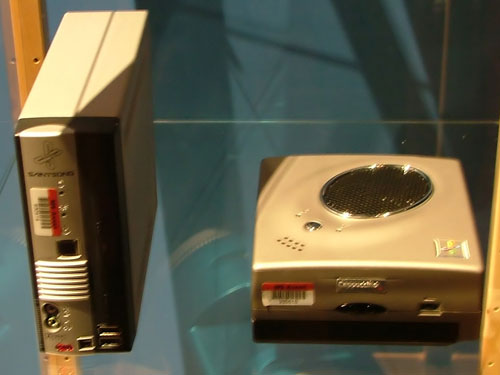
Here's a final shot of a couple small units from a company called SaintSong that were in the hardware showcase. We're not even sure what the specs are, but they're just barely thicker than a typical 5.25" DVD-RW drive while not being quite as long. Assuming the price, performance and features can at least match the Mac Mini - with perhaps better media support - we're sure there will be some interested buyers.
Just to reiterate, these are all prototype or reference designs at best. Interested vendors could add or remove features from any of these platforms in order to meet the demands of their target market. We may never see any of these specific units for sale, but the concepts presented could easily show up in next generation cable/set-top boxes. Microsoft's vision of a digital home is going to require a lot more than large ATX-size PCs, and these smaller devices are meant to fill those roles.










17 Comments
View All Comments
DerekWilson - Saturday, April 30, 2005 - link
heh ... not even the CPU editor has all the CPUs he needs. We've been passing our one set of dual core processors from both vendors around the globe. :-)JarredWalton - Friday, April 29, 2005 - link
The *official* plan is for Longhorn to be widely available by the holiday 2006 time frame (see day 1 coverage). However, I think XP-64 was supposed to be available over a year ago as well. Call me a skeptic....The point about going next year is that, from what I could tell, certain things are just repeated in slightly updated formats each year. Longhorn was discussed last WinHEC, and the information this time was simply a bit more concrete. There were still quite a few "this isn't yet finalized..." disclaimers throughout the presentations.
I suppose since I'm local to WinHEC (I'm in Olympia, WA), at the very least I'll be going to some of the MS events in the future. We'll have to see how that pans out. Maybe next time I can make it to the Sunday AMD Gaming gig and get a free Athlon 64 4000+? (Yeah, we missed out on that. Not that we don't have lots of hardware already, but having an extra CPU never hurts. Especially when you're not the CPU editor. Heheh)
PrinceGaz - Friday, April 29, 2005 - link
Fascinating. Probably the most relevent event report I've read. The IDF is interesting to see where the hardware is going, but it is the software that we use on a day to day basis, and what Microsoft are planning is likely to impact us the most in the next few years."At the end of the show, while we would definitely say that WinHEC doesn't have the appeal of Computex, E3, or some of the other larger shows, there was still plenty of good information to be found. Will we go again next year?"...
I can't believe you are even wondering whether to go again. Though if Anand is using his Mac all the time now and abandoned PCs, and those of you with PCs have switched from Windows to Linux, then I could understand your hesitation. I jest of course, but what happens with Microsoft is likely to be more important to the PC user than any hardware development, so there is no way you can neglect it.
I thought Longhorn was due out mid-2006, rather than "two years time". Longhron has seemed to be due out in "two years time" for quite a few years now, such that I wonder if it will ever actually arrive. And when it does arrive, will it actually contain many of the improvements originally touted over Windows 2000/XP (such as the central WinFS file-system which they decided would delay Longhorn too long). So are Microsoft officially saying 2007 is Longhorn year now?
Personally I'm in no hurry for Longhorn if it is crippled with DRM restrictions everywhere. The whole pointy of a PC is I can do what I wish with the media I have obtained, whether purchased or from other sources. I would say that being able to view perfect and complete "try before I buy" content has had the main effect with me of making me buy stuff I otherwise wouldn't have considered, rather than simply using it as an alternative to purchasing discs. Content protection that limits consumer choice (even if that choice includes free downloads) is and always has been detrimental to the industry.
JarredWalton - Friday, April 29, 2005 - link
DOS is still in use as a deployment tool. You can still license DOS from MS, but that will cease to be the case as of 2006. I work as an IT guy for a huge corporation, and our PC build process goes like this:1) Boot from floppy.
2) Select PC configuration.
3) Watch Drive Image clone the XP image to the HDD.
4) XP loads up and finishes the device enumeration, joins the appropriate domain, etc.
5) Choose SMS pacakages and wait.... (The final stages of the build process can take as long as an hour or two, depending on the SMS packages that are selected for installation.)
The problem is that getting DOS network drivers as well as support for newer technologies (SATA) is getting more and more difficult. The whole setup process would be more streamlined if HQ personnel didn't have to worry about DOS. I would wager that we'll still continue to use DOS and Drive Image for at least another 5 years, just because that's the way this corporation is, but it's nice to know that eventually they'll be forced to update the process to something that is hopefully faster and more robust.
icarus4586 - Friday, April 29, 2005 - link
"R.I.P. MS-DOS, 2005"This part of the article doesn't make much sense. The huge majority of Windows machines are either 2000 or XP, both of which are NT. NT does not run on DOS. MS-DOS was dead with WinME, and should have been dead far before.
ProviaFan - Friday, April 29, 2005 - link
Interesting stuff... Out of all of it, I found the (U)EFI coverage to be most intriguing, since normally the BIOS is one of the least represented PC components in computer news coverage. ;)stephenbrooks - Friday, April 29, 2005 - link
"One giant Microsoft fest"?? That got me saying "Ewww!" before I started the article. XD Images of hordes of Barney ActiMates™ coming to play with me came to mind.